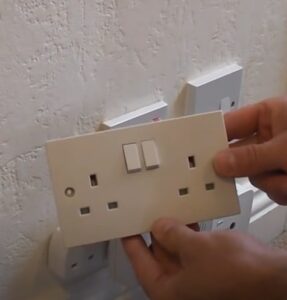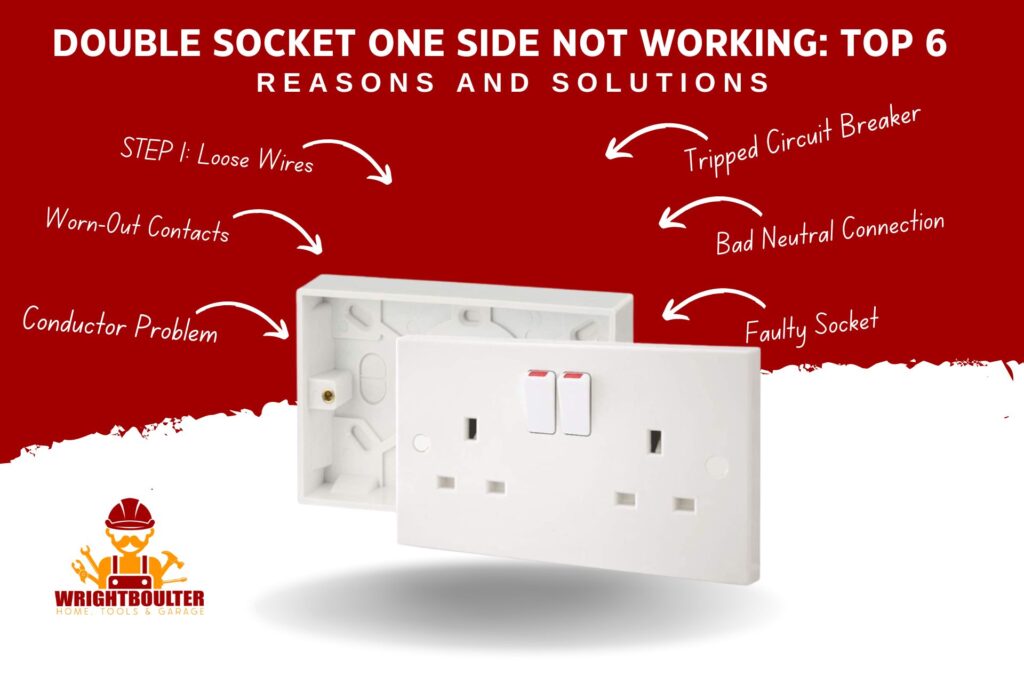Introduction
If you are a user of a double socket, you may notice one side of it doesn’t work sometimes.
So, you may be wondering why is double socket one side not working.
A tripped circuit breaker, damaged wires, loose connection, and bad neutral connection are some of the reasons behind double sockets on one side not working. You can solve this by resetting the circuit breaker, tightening the loose connection or replacing the severely damaged wires, and fixing the neutral connection respectively.
To know the reasons and solutions in a detailed manner, stick with the article.
Double Socket One Side Not Working: Quick Overview of Common Reasons And Solutions
The table below shows the reasons and solutions associated with the double sockets on one side not working.
| Reasons | Solutions |
| Loose wires | Tighten the wires |
| Tripped circuit breaker | Reset the circuit breaker |
| Conductor problem | Fixing the conductor |
| Bad neutral connection | Fix the connection |
| Worn out contacts | Replace the faceplate |
| Faulty Socket | Replace the socket |
It’s time to look into the reasons and solutions in a broader manner so that you can solve the issue as yourself.

Detailed Discussion of Reasons And Solutions
The following is a detailed discussion of six possible reasons and solutions for the double socket on one side not working.
Reason 1: Loose Wires
A socket cannot conduct current properly if its wires are not secured to the electrical supply.
Solution
To get over the situation, you need to tighten the loose wires connection. By following these steps, you will be able to do it easily.
Required tool: Screwdriver
Here is how to tighten a loose wire connection in a double socket
Step 1: First you need to check the wires closely for any damage or signs of wear and tear. You may need to replace the wires entirely if you notice any problems. If it’s not damaged, there is a high chance that it lose. So it needs to be tightened.
Step 2: Turn off the electricity to the circuit before working on the socket. This can be done by switching off the circuit breaker or removing the fuse.
Step 3: Now, unscrew the screws that are holding the socket cover plate in place and gently remove them.
Step 4: Then, use the screwdriver to tighten the screws that are holding the wires in place. Make sure to apply enough pressure to ensure a tight connection but avoid over-tightening, which could damage the screws.
Step 5: Now, once you are satisfied with the connections, reattach the socket cover plate and screw it in place.
Reason 2: Tripped Circuit Breaker
The function of circuit breakers is to regulate the flow of electricity to different areas of your home. Whenever the electrical current exceeds safe limits, the circuit breaker gets tripped to stop the charges from flowing.
Solution
To get over the situation you need to reset the tripped circuit breaker.
Step 1: First, locate the circuit breaker. You can easily identify the tripped breaker as it will be situated between the on and off positions.
Step 2: Then, you need to switch off the breaker position and then back on.
Reason 3: Conductor Problem
A double socket typically has two outlets, each connected to a separate conductor or wire. If one of these conductors is damaged, loose, or broken, it can disrupt the flow of electricity to one of the outlets, causing it to stop working.
Solution
Required tools: Industrial grade brake cleaner (non-chlorinated), and screwdriver.
Procedure:
Step 1: The first step is to disconnect the electricity source of the socket and identify which side of the double socket is not working.
Step 2: Now, you should remove the socket base plate from the wall by unscrewing the screw with the screwdriver.
Step 3: Then, check the conductors to find out any damage. To do this you have to disconnect the wires from the hot wire screws and open the hot wire screws completely using screwdrivers.
If you find out any damage, it needs to be replaced. If there is no damage, go for the next step.
Step 4: Now, the socket faceplate should be removed. Then the conductor plates must be thoroughly cleaned using industrial-grade cleaner (non-chlorinated brake cleaner). Once the blockage is removed, the socket can be reassembled.
Reason 4: Bad Neutral Connection
The neutral wire is a critical component of the electrical circuit that completes the path for the flow of electricity, along with the hot wire.
Solution
Step 1: First, turn off the power supply. use a voltage tester to check there is no voltage present in the circuit.
Step 2: Then, to identify the location of the bad neutral connection, inspect the wiring and look for damage such as broken or frayed wires.
Step 3: Now, if you find any wear and tear in the wires, you can strip the insulation off the wires, twist the exposed ends together and cover them with electrical tape.
However, if you find the wires are severely damaged you must replace the wiring.
Reason 5: Worn-Out Contacts
The contacts are responsible for making the electrical connection between the socket and the plug. If the contacts are worn out or damaged, they are not able to make a proper connection with the plug.
Solution
First, inspect the contacts very carefully to find out the wear of the contacts. You have to replace the damaged faceplate with a brand-new one. Replacing a faceplate is not hard. You can do it easily just by following the video.
Socket face plate change
Reason 6: Faulty Socket
If the socket is old, it may simply be worn out and no longer functioning properly. Also, over time the wiring inside the socket can be damaged for exceeding use.
Solution
If the issue is a faulty socket, you must change it without wasting your time. The cost of a new double socket will be around $3- $30 depending on the quality.
It is important to have a qualified electrician to ensure that the replacement job has been done in a safe manner.
FAQs
Are Double Sockets Safe?
Double sockets are generally safe to use as long as they are installed and used correctly. The double socket can lead to overheating and fires. If you want to avoid any hazardous situation, you need to install and use it properly.
How Many Watts Can A Double Socket Take?
The number of watts that a double socket can take depends on the amperage rating of the socket. A typical double socket is rated for 15 amps, which means it can safely provide and carry a combined total load of up to 1500 watts maximum using #14 AWG wires.
Where Is The Fuse In A Double Socket?
The fuse box in a double socket is situated between the two metal holders inside the plug. The purpose of a fuse or circuit breaker is to protect the electrical circuit from overload, which can cause overheating and potentially lead to a fire.
Conclusion
Hopefully, you’ve tracked down the exact causes and the respective solutions to why your double socket on one side not working.
Some issues are easy enough to solve on your own. For other issues, you may need to manage professional assistance to get over the situation.
Best wishes for your venture!



